2014 SUBARU TRIBECA belt
[x] Cancel search: beltPage 6 of 426
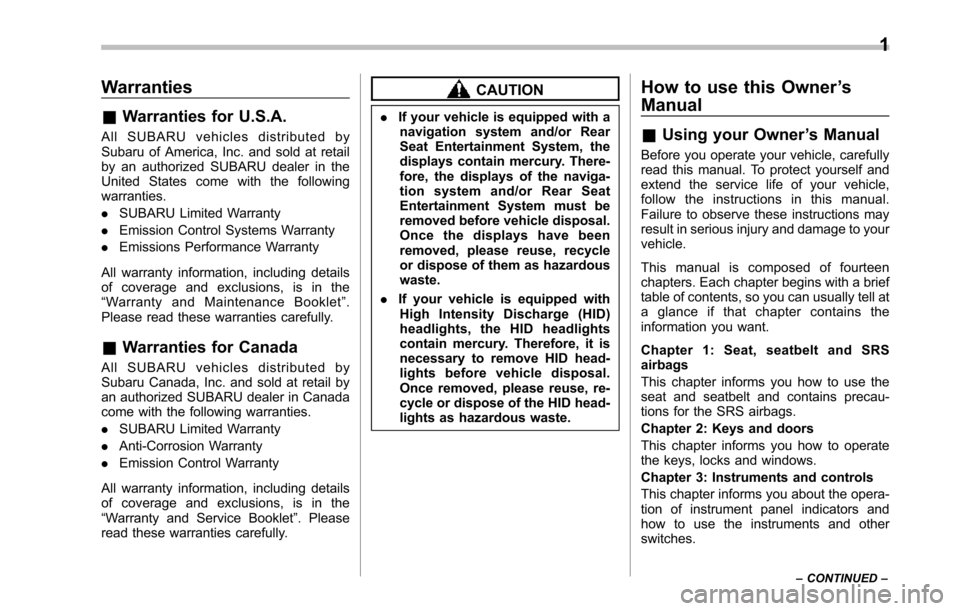
Warranties
&Warranties for U.S.A.
All SUBARU vehicles distributed bySubaru of America, Inc. and sold at retailby an authorized SUBARU dealer in theUnited States come with the followingwarranties.
.SUBARU Limited Warranty
.Emission Control Systems Warranty
.Emissions Performance Warranty
All warranty information, including detailsof coverage and exclusions, is in the“Warranty and Maintenance Booklet”.Please read these warranties carefully.
&Warranties for Canada
All SUBARU vehicles distributed bySubaru Canada, Inc. and sold at retail byan authorized SUBARU dealer in Canadacome with the following warranties.
.SUBARU Limited Warranty
.Anti-CorrosionWarranty
.Emission Control Warranty
All warranty information, including detailsof coverage and exclusions, is in the“Warranty and Service Booklet”. Pleaseread these warranties carefully.
CAUTION
.If your vehicle is equipped with anavigation system and/or RearSeat Entertainment System, thedisplays contain mercury. There-fore, the displays of the naviga-tion system and/or Rear SeatEntertainment System must beremoved beforevehicle disposal.Once the displays have beenremoved, please reuse, recycleor dispose of them as hazardouswaste.
.If your vehicle is equipped withHigh Intensity Discharge (HID)headlights, the HID headlightscontain mercury. Therefore, it isnecessary to remove HID head-lights before vehicle disposal.Once removed, please reuse, re-cycle or dispose of the HID head-lights as hazardous waste.
How to use this Owner’s
Manual
&Using your Owner’s Manual
Before you operate your vehicle, carefullyread this manual. To protect yourself andextend the service life of your vehicle,follow the instructions in this manual.Failure to observe these instructions mayresult in serious injury and damage to yourvehicle.
This manual is composed of fourteenchapters. Each chapter begins with a brieftable of contents, so you can usually tell ataglanceifthatchaptercontainstheinformation you want.
Chapter 1: Seat, seatbelt and SRSairbags
This chapter informs you how to use theseat and seatbelt and contains precau-tions for the SRS airbags.
Chapter 2: Keys and doors
This chapter informs you how to operatethe keys, locks and windows.
Chapter 3: Instruments and controls
This chapter informs you about the opera-tion of instrument panel indicators andhow to use the instruments and otherswitches.
1
–CONTINUED–
Page 10 of 426
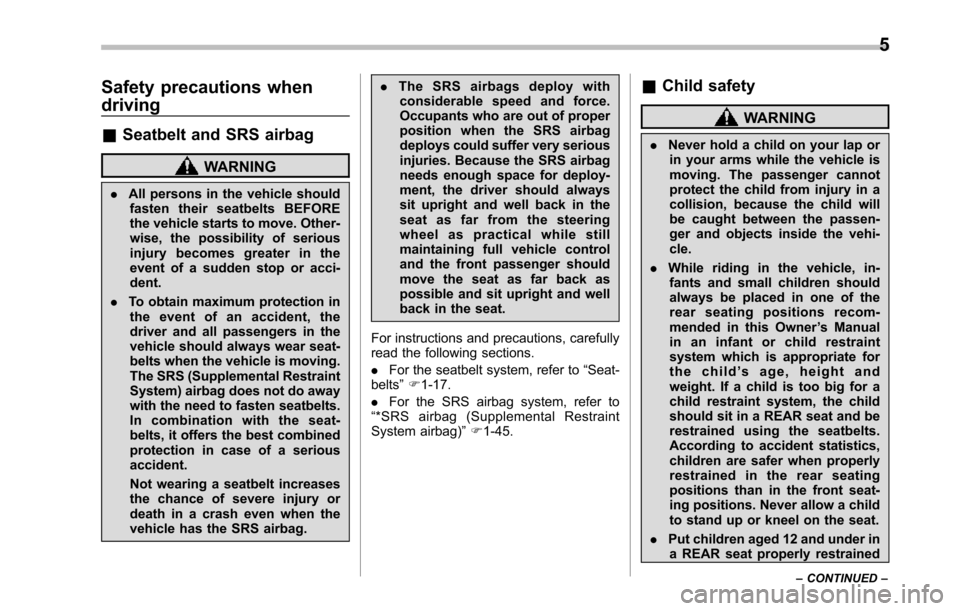
Safety precautions when
driving
&Seatbelt and SRS airbag
WARNING
.All persons in the vehicle shouldfasten their seatbelts BEFOREthe vehicle starts to move. Other-wise, the possibility of seriousinjury becomes greater in theevent of a sudden stop or acci-dent.
.To obtain maximum protection inthe event of an accident, thedriver and all passengers in thevehicle shouldalways wear seat-belts when the vehicle is moving.The SRS (Supplemental RestraintSystem) airbag does not do awaywith the need to fasten seatbelts.In combination with the seat-belts, it offers the best combinedprotection in case of a seriousaccident.
Not wearing a seatbelt increasesthe chance of severe injury ordeath in a crash even when thevehicle has the SRS airbag.
.The SRS airbags deploy withconsiderable speed and force.Occupants who are out of properposition when the SRS airbagdeploys could suffer very seriousinjuries. Because the SRS airbagneeds enough space for deploy-ment, the driver should alwayssit upright and well back in theseat as far from the steeringwheel as practical while stillmaintaining full vehicle controland the front passenger shouldmove the seat as far back aspossible and sit upright and wellback in the seat.
For instructions and precautions, carefullyread the following sections.
.For the seatbelt system, refer to“Seat-belts”F1-17.
.For the SRS airbag system, refer to“*SRS airbag (Supplemental RestraintSystem airbag)”F1-45.
&Child safety
WARNING
.Never hold a child on your lap orin your arms while the vehicle ismoving. The passenger cannotprotect the child from injury in acollision, because the child willbe caught between the passen-ger and objects inside the vehi-cle.
.While riding in the vehicle, in-fants and small children shouldalways be placed in one of therear seating positions recom-mended in this Owner’s Manualin an infant or child restraintsystem which is appropriate forthe child’sage,heightandweight. If a child is too big for achild restraint system, the childshould sit in a REAR seat and berestrained using the seatbelts.According to accident statistics,children are safer when properlyrestrained in the rear seatingpositions than in the front seat-ing positions. Never allow a childto stand up or kneel on the seat.
.Put childrenaged 12 and under ina REAR seat properly restrained
5
–CONTINUED–
Page 11 of 426
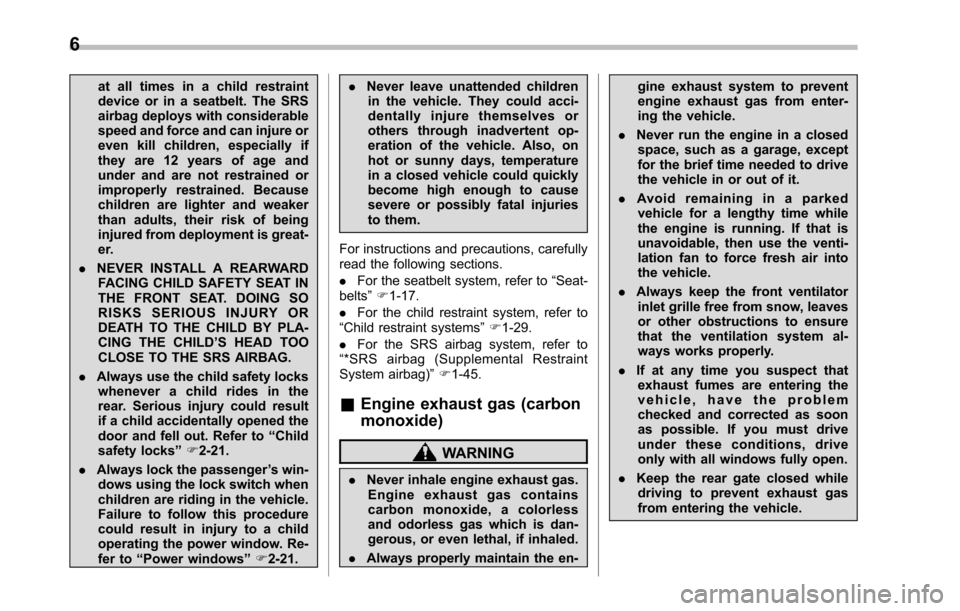
6
at all times in a child restraintdevice or in a seatbelt. The SRSairbag deploys with considerablespeed and force and can injure oreven kill children, especially ifthey are 12 years of age andunder and are not restrained orimproperly restrained. Becausechildren are lighter and weakerthan adults, their risk of beinginjured from deployment is great-er.
.NEVER INSTALL A REARWARDFACING CHILD SAFETY SEAT INTHE FRONT SEAT. DOING SORISKS SERIOUS INJURY ORDEATH TO THE CHILD BY PLA-CING THE CHILD’S HEAD TOOCLOSE TO THE SRS AIRBAG.
.Always use the child safety lockswhenever a child rides in therear. Serious injury could resultif a child accidentally opened thedoor and fell out. Refer to“Childsafety locks”F2-21.
.Always lock the passenger’s win-dows using the lock switch whenchildren are riding in the vehicle.Failure to follow this procedurecould result in injury to a childoperating the power window. Re-fer to“Power windows”F2-21.
.Never leave unattended childrenin the vehicle. They could acci-dentally injure themselves orothers through inadvertent op-eration of the vehicle. Also, onhot or sunny days, temperaturein a closed vehicle could quicklybecome high enough to causesevere or possibly fatal injuriesto them.
For instructions and precautions, carefullyread the following sections.
.For the seatbelt system, refer to“Seat-belts”F1-17.
.For the childrestraint system, refer to“Child restraint systems”F1-29.
.For the SRS airbag system, refer to“*SRS airbag (Supplemental RestraintSystem airbag)”F1-45.
&Engine exhaust gas (carbon
monoxide)
WARNING
.Never inhale engine exhaust gas.Engine exhaust gas containscarbon monoxide, a colorlessand odorless gas which is dan-gerous, or even lethal, if inhaled.
.Always properly maintain the en-
gine exhaust system to preventengine exhaust gas from enter-ing the vehicle.
.Never run the engine in a closedspace, such as a garage, exceptfor the brief time needed to drivethe vehicle in or out of it.
.Avoid remaining in a parkedvehicle for a lengthy time whilethe engine is running. If that isunavoidable, then use the venti-lation fan to force fresh air intothe vehicle.
.Always keep the front ventilatorinlet grille free from snow, leavesor other obstructions to ensurethat the ventilation system al-ways works properly.
.If at any time you suspect thatexhaust fumes are entering thevehicle, have the problemchecked and corrected as soonas possible. If you must driveunder these conditions, driveonly with all windows fully open.
.Keep the rear gate closed whiledriving to prevent exhaust gasfrom entering the vehicle.
Page 13 of 426
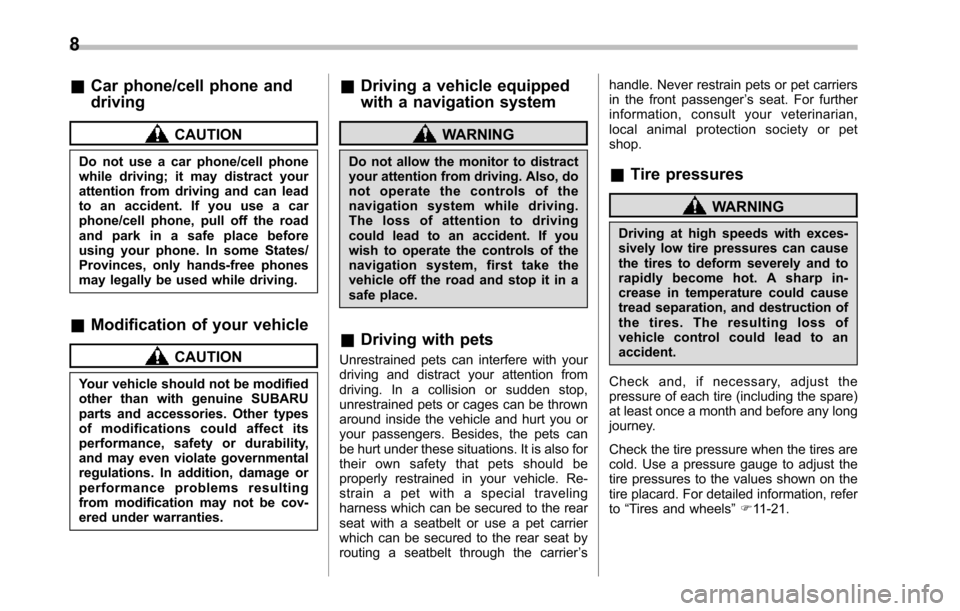
8
&Car phone/cell phone and
driving
CAUTION
Do not use a car phone/cell phonewhile driving; it may distract yourattention from driving and can leadto an accident. If you use a carphone/cell phone, pull off the roadand park in a safe place beforeusing your phone. In some States/Provinces, only hands-free phonesmay legally be used while driving.
&Modification of your vehicle
CAUTION
Your vehicle should not be modifiedother than with genuine SUBARUparts and accessories. Other typesof modifications could affect itsperformance, safety or durability,and may even violate governmentalregulations. In addition, damage orperformance problems resultingfrom modification may not be cov-ered under warranties.
&Driving a vehicle equipped
with a navigation system
WARNING
Do not allow the monitor to distractyour attention from driving. Also, donot operate the controls of thenavigation system while driving.The loss of attention to drivingcould lead to an accident. If youwish to operate the controls of thenavigation system, first take thevehicle off the road and stop it in asafe place.
&Driving with pets
Unrestrained pets can interfere with yourdriving and distract your attention fromdriving. In a collision or sudden stop,unrestrained pets or cages can be thrownaround inside the vehicle and hurt you oryour passengers. Besides, the pets canbe hurt under these situations. It is also fortheir own safety that pets should beproperly restrained in your vehicle. Re-strain a pet with a special travelingharnesswhich can be secured to the rearseat with a seatbelt or use a pet carrierwhich can be secured to the rear seat byrouting a seatbelt through the carrier’s
handle. Never restrain pets or pet carriersin the front passenger’s seat. For furtherinformation, consult your veterinarian,local animal protection society or petshop.
&Tire pressures
WARNING
Driving at high speeds with exces-sively low tirepressures can causethe tires to deform severely and torapidly become hot. A sharp in-crease in temperature could causetread separation, and destruction ofthe tires. The resulting loss ofvehicle control could lead to anaccident.
Check and, if necessary, adjust thepressure of each tire (including the spare)at least once a month and before any longjourney.
Check the tire pressure when the tires arecold. Use a pressure gauge to adjust thetire pressures to the values shown on thetire placard. For detailed information, referto“Tires and wheels”F11-21.
Page 14 of 426
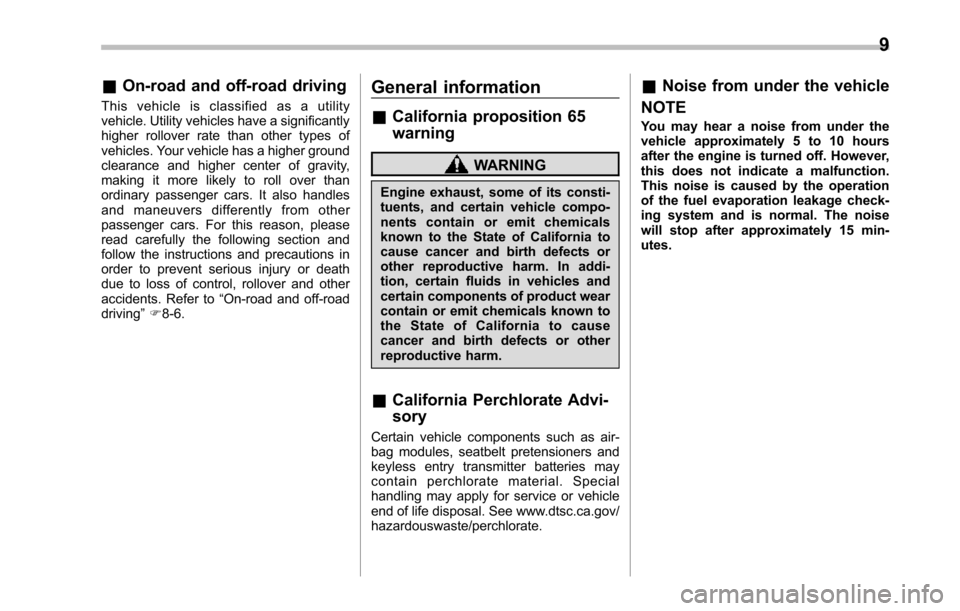
&On-road and off-road driving
This vehicle is classified as a utilityvehicle. Utility vehicles have a significantlyhigher rollover rate than other types ofvehicles. Your vehicle has a higher groundclearance and higher center of gravity,making it more likely to roll over thanordinary passenger cars. It also handlesand maneuvers differently from otherpassenger cars. For this reason, pleasereadcarefully the following section andfollow the instructions and precautions inorder to prevent serious injury or deathdue to loss of control, rollover and otheraccidents. Refer to“On-road and off-roaddriving”F8-6.
General information
&California proposition 65
warning
WARNING
Engine exhaust, some of its consti-tuents, and certain vehicle compo-nents contain or emit chemicalsknown to the State of California tocause cancer and birth defects orother reproductive harm. In addi-tion, certain fluids in vehicles andcertain components of product wearcontain or emit chemicals known tothe State of California to causecancer and birth defects or otherreproductive harm.
&California Perchlorate Advi-
sory
Certain vehicle components such as air-bag modules, seatbelt pretensioners andkeyless entry transmitter batteries maycontain perchlorate material. Specialhandling may apply for service or vehicleend of life disposal. See www.dtsc.ca.gov/hazardouswaste/perchlorate.
&Noise from under the vehicle
NOTE
You may hear a noise from under thevehicle approximately 5 to 10 hoursafter the engine is turned off. However,this does not indicate a malfunction.This noise is caused by the operationof the fuel evaporation leakage check-ing system and is normal. The noisewill stop after approximately 15 min-utes.
9
Page 16 of 426
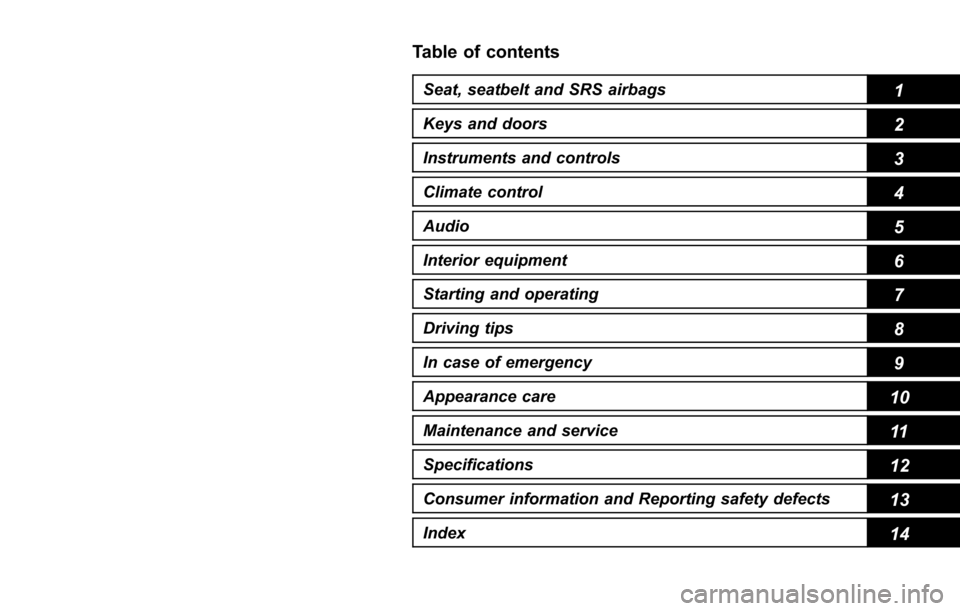
Table of contents
Seat, seatbelt and SRS airbags1
Keys and doors2
Instruments and controls
Climate control4
Audio5
Interior equipment6
Starting and operating7
Driving tips8
In case of emergency9
Appearance care10
Maintenance and service11
Specifications12
Consumer information and Reporting safety defects13
Index14
3
Page 19 of 426
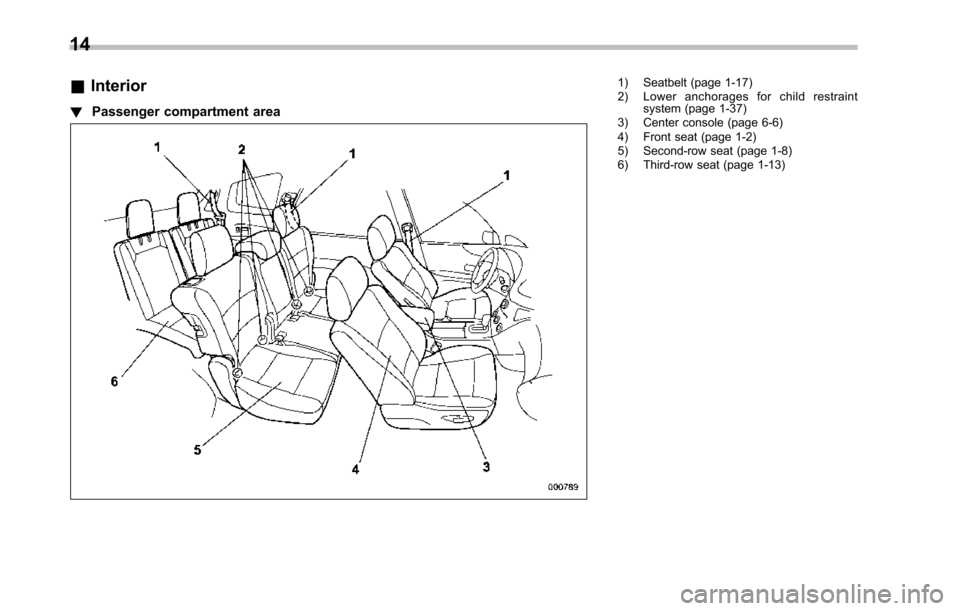
14
&Interior
!Passenger compartment area
1) Seatbelt (page 1-17)2) Lower anchorages for child restraintsystem (page 1-37)3) Center console (page 6-6)4) Front seat (page 1-2)5) Second-row seat (page 1-8)6) Third-row seat (page 1-13)
Page 20 of 426
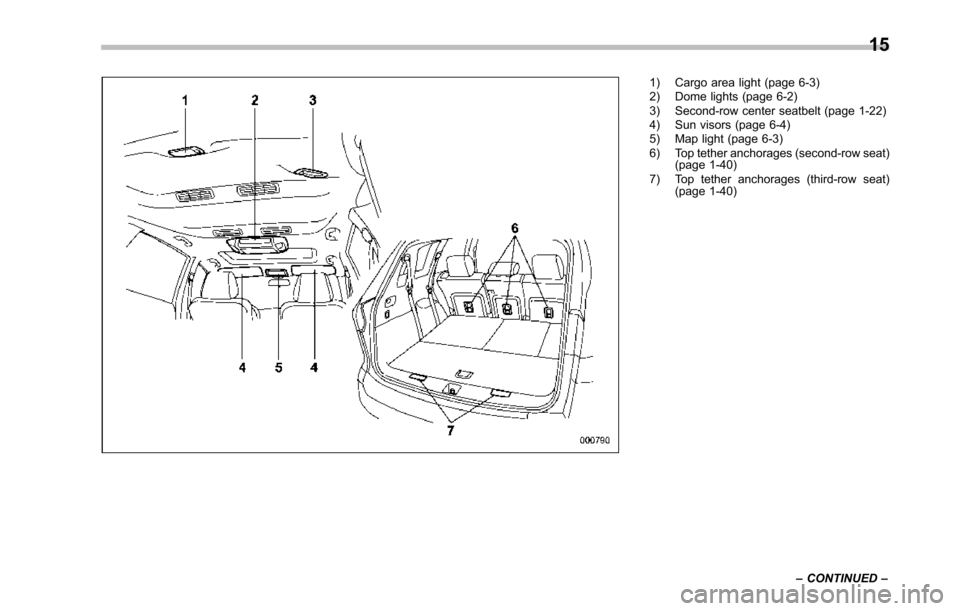
1) Cargo area light (page 6-3)2) Dome lights (page 6-2)3) Second-row center seatbelt (page 1-22)4) Sun visors (page 6-4)5) Map light (page 6-3)6) Top tether anchorages (second-row seat)(page 1-40)7) Top tether anchorages (third-row seat)(page 1-40)
15
–CONTINUED–